I recently found a detailed interview with Dolly Tree in the Daily Express from January 1922 in the British Newspaper Archive. This feature was not available during the research for my biography Dolly Tree: A Dream of Beauty and so the information it provides was not included. So here is the text and commentary as it does show some invaluable and interesting points.
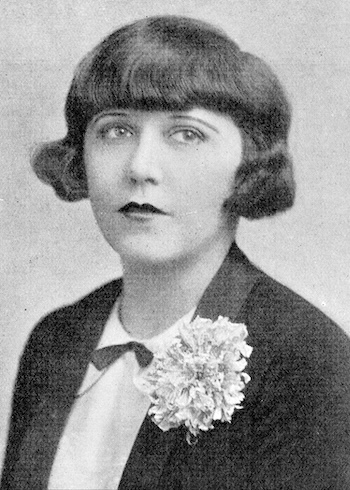
Dollie Tree—Dress Designer
English Girl Who Creates for Paris Stage
‘Dresses designed by Dollie Tree’ has appeared on a number of programs of splendid productions for some time past, but the clever young girl, who has designed within the past six or seven years ago some thousands of most original dresses for the stage is barely out of her teens and it seems incredible to realize that she has been responsible of gowns in more than eighteen shows.
Among the productions in which her handiwork has appeared mention might be made of the Peep Show and Jack and the Beanstalk (save the Plum pudding ballet) at the London Hippodrome; The Windmill Man at the Victoria Palace (also the scenery); the Midnight Frolics with its gold and silver ballet at the Hotel Metropole. In Birmingham she designed the dresses for the Queen of Hearts pantomime with its Card Ballet and Old English tournament scene.
It is however, a special feather in her cap that a young English girl should have also gained fame in Paris, where she designed all the dresses for the Concert Mayol revue last year and most of the dresses for the forthcoming revue at Les Folies Bergere, while last November she was responsible for all the dresses in a Spanish revue at Barcelona as well as many of the costumes for a revue at Marseilles and one at Lyon.
‘I was on the stage as a child’ Miss Tree told me ‘and when I left it my thoughts were first turned towards film work. But I always liked designing dresses, either fro myself or my friends at home, or for girl friends on the stage and I got my first chance in a revue called Charlie Chaplin Mad.’
Thinking in Colour
‘My method is difficult to described. If there is such a thing as ‘thinking in colour’ I can best described that as the attribute which is behind all my efforts. I get my inspiration from sitting in front of a piece of blank paper, because when I find a pencil or a paint brush in my hand, I immediately want to express something on it and I have always felt that way. I might add, too that I am left-handed,’
‘I love one-colour schemes on the stage and I dread a medley of colour, which often is bewildering without being beautiful. Colours convert sensations to my mind. For instance, scarlet is a noisy, riotous colour and blue, mauve and green are restful, while cerise, orange and yellow denote joy.
Some of the most wonderful stage effects have been in black and white. Nowadays we have gone too far in the development of gorgeous materials and colours for stage wear. The amount of gold, silver and crystal used is remarkable and there is a distinct feeling for huge effects. A big headless is never seen to better advantage than on the stage and really should not be worn anywhere else, because being seen at a distance and on a height it is seen under ideal conditions.’
Fantastic Headdress.
‘In Paris there is a great feeling for the wildly eccentric and bizarre for stage wear. Headdresses are fantastic and colossal. Stage gowns are designed to interest and amuse the womenfolk in the audience, and therefore I have designed whole scenes depicting articles of attire for women. For instance, I have arranged one scene in which each girl represents a kind of handbag. and each girl is different. In another 1 had & ballet of fans. One sucesssful scene represented the various articles used by a woman in making her toilet, and yet another notion was carried out to show muffs of every fantastic kind.
“The French have, I think, a better idea of wearing fantastic clothes than the English, probably because, as a race, the French women dress better than women of any other country. or, should 1 say. they wear their clothes with a better air and distinctiveness. In Paris, too, it is easy to design clothes, because heing a city where models are made, the shops seem to stock the most unusual colours and fabrics and embroideries which are such a joy to the creator of noveltjes. 1 have no set plan of work. T receive the script of a new show, with instructions to design, say, for shepherdresses, for milk maids, or fine ladies, or anything else you may think about. There is no idea which cannot be carried out nowadays when we range from futurism to fantasy, and shows have never been so beautifully and expensively dressed.’
Sources
Dolly Tree: A Dream of Beauty by Gary Chapman
Erte by Charles Spencer
Daily Express 26 January 1922
Le Petit Marseilles 27/11/1922
Programmes for The Windmill Man, the Peepshow, Jack and Beanstalk, Zig Zag, L’Amour En Folies, Folies Sur Folies and Tout Feu Tout Femme.
All images (unless specified in the caption) and text © copyright Gary Chapman / Jazz Age Club and must not be re-used without prior consent
Notes and Observations
The Windmill Man was given its first performance on 26th December 1921 at the Victoria Palace Theatre.
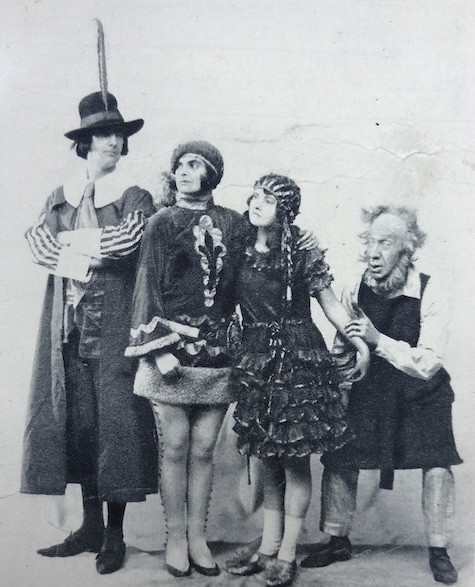
See the post about The Magic of the Windmill Man here
The Peepshow was staged at the London Hippodrome in April 1921
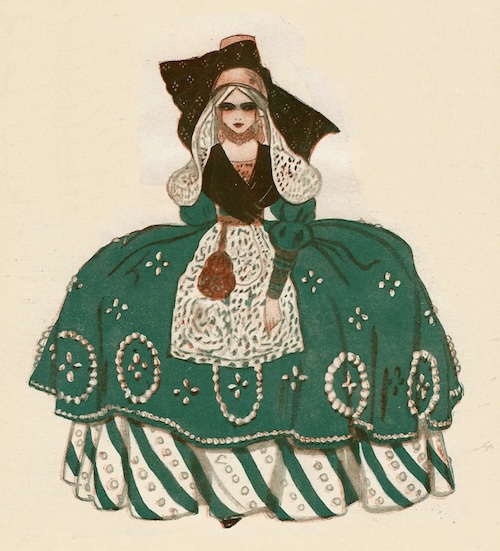
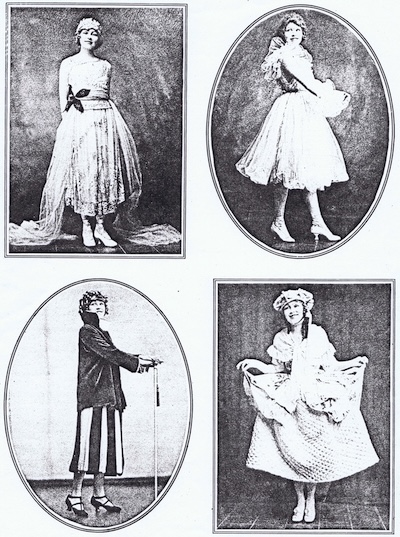
See the post about the Peepshow here
‘The Midnight Frolics with its gold and silver ballet at the Hotel Metropole’ refers to the first cabaret show called The Midnight Follies staged at the Hotel Metropole in November 1921
Jack and the Beanstalk was staged at the London Hippodrome from December 1921 with Clarice Mayne as the star
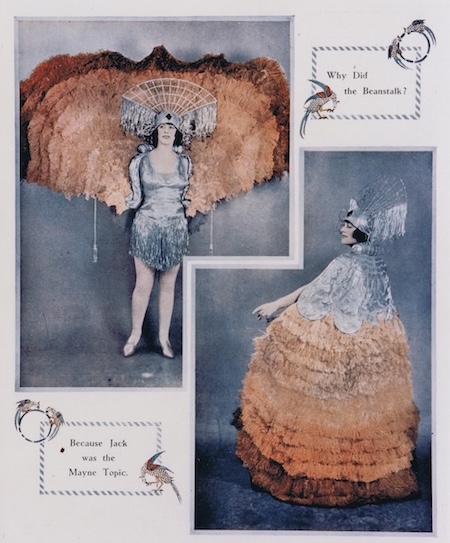
Max Weldy
Regarding the shows in Barcelona and Marseilles – it is highly likely that Dolly Tree’s creations were seen in both places via the Paris costumier Max Weldy. From 1919 he was allied to the Folies Bergere. For the first four editions of the Folies Bergere shows – from 1919 through to 1922 – the designers Weldy used appear to have been Dolly Tree, Erte and Jean le Seyeux. They may have designed costumes first for the Folies Bergere and then the designs were re-used elsewhere including for Barcelona and Marseilles. In some instances the designs were also re-used at other Paris music halls like the Concert Mayol. Obviously, some designs were also specially created for each particular venue and show.
The revue in Barcelona must have been Zig Zag (1921-1922), a Fernando Bayes revue at the Principal Palace with Cynthia and Iris Goode, Mado Minty and Ernest Marini. The programme simply credits Max Weldy in Paris as executing the costumes. In the programme the first scene was el cuarto poder or The Fourth Estate, a metaphor for the press or media. Here the cast appeared representing various worldwide newspapers and magazines. Iris Goode was dressed as Le Pele Mele – a French weekly satirical and humorous magazine. In 1970 in a Sotheby sale of Parisian costume designs, a Dolly Tree sketch entitled Pele Mele (with Dolly Tree’s signature dating to 1920-1922) was sold.
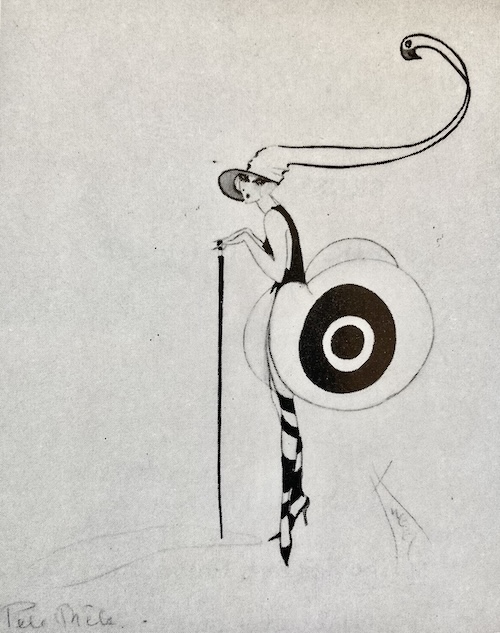
Since Dolly Tree mentioned she had designed a ballet of fans and another representing the various articles used by a woman in making her toilet, it is relevant that Zig Zag featured the scenes Los abanicos de plumes (feather fans) and Los artificios de la mujer (the artifices of women). This does suggest that she did design the costumes for most, if not all, of the costumes in the other scenes.
See the post on the Goode Sisters here
A post about Dolly Tree and Spain is forthcoming
Dolly Tree had contributed costume designs to the 1920 Folies Bergere show ‘L’Amour En Folies’ staged in March 1920 and she also may have been involved in the 1919 Folies Bergere show Paris Vertige.
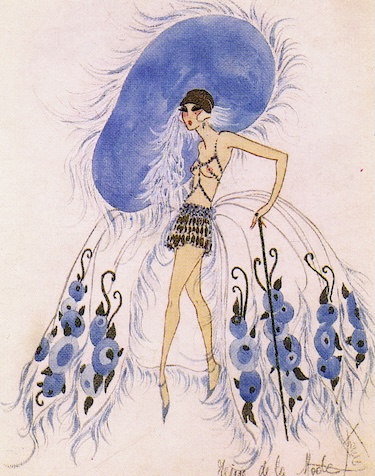
The ‘forthcoming revue at the Folies Bergere’ was the show ‘Folies Sur Folies’ staged in Spring 1922 where Dolly Tree designed the bulk of the costumes.
The Concert Mayol show was Tout Feu Tout Femme that was staged in January 1921. The costumes were in fact designed by Dolly Tree, Jean Le Seyeux and Mlle Vilpelle but it is not clear which designer designed each scene. The costumes were executed by Pascaud, another major costume firm like Max Weldy but much older. Dolly Tree had used Pascaud to execute some of her costumes for the Wylie pantomime Puss in Boots staged in Glasgow in late 1920, Wylie’s revue The Peepshow at the Hippodrome (1921) and Philip Rodway’s pantomime Queen of Hearts in Birmingham for Christmas 1921.
The show in Marseilles may have been La Revue Tu Galejes (1921 / Alcazar) but she most definitely contributed to Oh! Que Fortune (1921-1922) at the Alcazar. One of the scenes was L’Ecole des Perruches with representations of Le Perruche (Parakeet), le Perroquet (Parrot), Les Aras (Macaws) and L’Oiseau de Feu (the firebird). The scene was described as ‘a true marvel of originality.’
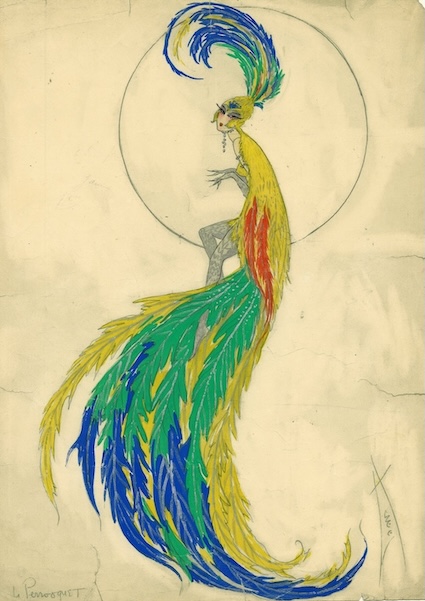
It is possible that some of these bird designs may have resurfaced in the Folie Bergere show Folies Sur Folies (1922). The designs were most definitely re-used in the Concert Mayol show T’en as du Vice staged in June 1922 as La Cage Des Perruches. There are two extant designs by Dolly Tree that attest to her designing this scene; that of le Perroquet and L’Oiseau de Feu each with her distinctive signature dating to 1920-1922.
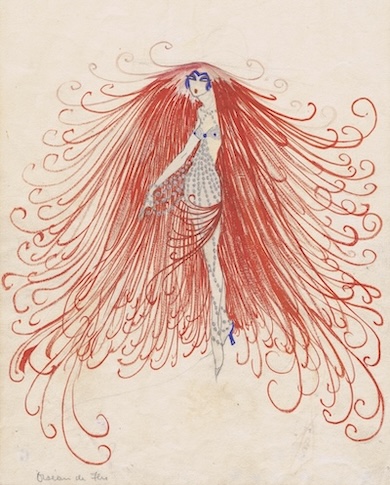
On reflection in an interview, in late 1923, Dolly Tree observed that she had designed the costumes for a ‘hashish’ number in Marseilles. Various sketches for ‘drugs’ survive including one for ‘Hashish’ and several different variants of Opium. Since there was a scene dealing with an opium den in Oh! Que Fortune, perhaps these designs were by Dolly Tree (they may have derived from the Folies Bergere show Paris Vertige from 1919). Of interest there was a similar scene in the Barcelona show Chofer al Palace in late 1920.
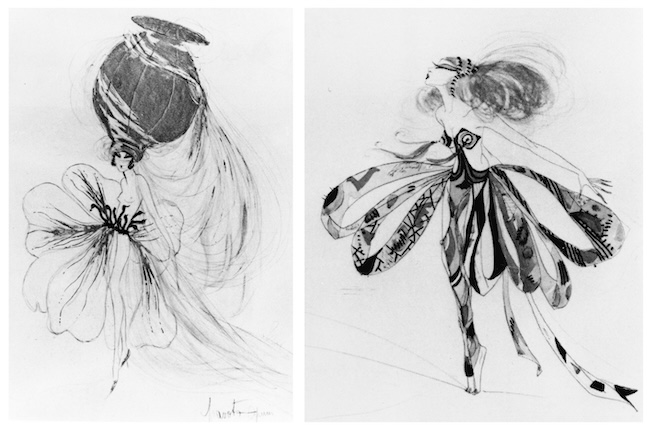
Of significance there were also two further scenes from Max Weldy at the Folies Bergere designed by Erte – one about Venice (from 1919) and the other the Kisses / Baisirs (1922). Both scenes were featured in two different shows at the Principal Palace in Barcelona.
It is also worth mentioning that Erte (via Max Weldy) provided designs for the Alcazar in Marseilles in late 1922 for Les Trésors de l’Indochine seen in the revue C’est Formidable. It is likely Dolly Tree contributed designs for this show.
The show in Lyon is unknown
One thing that was not mentioned in the interview was that in the Summer of 1921, Dolly Tree designed a series of gowns for publicity purposes to show the uses of Crysede Silk created by Alec Walker in Cornwall.
See the post about Dolly Tree and Crysede here.
All images (unless specified in the caption) and text © copyright Gary Chapman / Jazz Age Club and must not be re-used without prior consent

